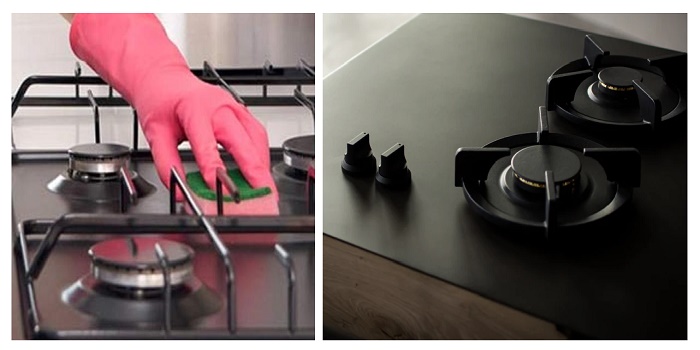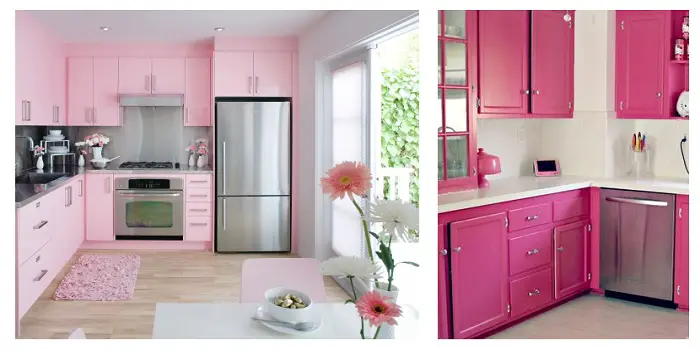
The enamel that covers your stovetop is a type of porcelain that is tough, durable, and designed to repel stains and scratches.
It’s also an insulator, so you can touch most of the stove with your bare hands even when in operation.
And while it is quite tough and durable, it can still be scratched or chipped, which means repairs are needed.
What follows are a few simple steps where you can repair your stovetop from the minor dents, dings, and scratches.
This will save you a considerable amount compared to replacing the stovetop or purchasing a new stove.
What's Here in the Article:
How to Repair the Enamel of Your Old Stove Top?
Let’s get started with the very first step, which is…
Sanding & Wiping…
Obtain some 400-grit sandpaper and sand along with the damaged areas.
You’ll want to smooth down any rough edges along the length of the damaged stovetop.
Once you have sanded the area thoroughly, wipe away any dust or debris that might be remaining.
The area that needs to be repaired must be free of any dust.
Applying Porcelain Repair Liquid…
You’ll need to purchase high-temperature porcelain repair liquid.
This will ensure the repair stays solid to temperatures up to 400 degrees or higher.
You can purchase a repair liquid that matches the color of the stovetop, so you will not need to do any additional painting.
You may need to mix different liquids to get the right color.
Warning: Do not attempt to repair the porcelain inside the stove or oven.
The temperatures inside are far greater than the liquid is designed to handle, so it will melt away quickly.
Keep all repair efforts to the outside stovetop when using porcelain repair liquid.
Once the mixture is ready, shake it thoroughly in the bottle before applying. Simply apply the liquid to the damaged area until it fills it up.
For really deep dents and cracks, you may need to add additional coats after it dries.
Wait five minutes after applying the first coat of the repair liquid, so it can dry properly.
If you have any liquid spill over, wipe it away immediately before it has a chance to dry.
If you have a damaged area around a curve, angle, or dip, you can use the repair liquid in combination with 600 or 1000-grit sandpaper.
Simply add the repair liquid to the cleaned-out area, then sand after each coat dries.
Once you have applied the final coat, do not sand it and instead let it sit so it can dry with a smooth surface.
How to Repaint and Refinish Your Stovetop Just Like New?
Now that you have made the repairs, you may want to repaint your stove if it is looking old or worn.
Repainting is a fraction of the cost compared to replacing a stove, so if you want to save money then repainting may be the best option.
Since everything starts with the paint, you will need to purchase paint that can withstand the heat and humidity generated by the stove.
This means a high-temperature porcelain enamel paint that is designed for appliances.
This type of paint has an epoxy base which means it dries to a hard finish.
A type of finish that can withstand porcelain cleaners and hold up yearly.
Once you have purchased the paint in the color you want, you are ready to start.
Step 1- Prep the Stove & Kitchen
Turn off the stove at the breaker box, so there is no chance of accidentally turning it on.
Next, slide out or remove the drawer under the oven compartment and pull the cord from the wall outlet for extra safety.
If it is a gas stove, have a qualified professional shut off the gas line.
Next, open the windows and place a fan on the window sill, pointing it outward.
This will pull any fumes from the kitchen to the outside.
Remove all burners or grates depending on the type of stove you own. Pull all knobs off the stove as well.
Step 2- Clean
Before you can paint, you must thoroughly clean the stove using a window cleaner.
Window cleaners are preferable since they are not oil-based.
An oil-based cleaner will leave behind a residue making it more difficult for the paint to stick.
The items you removed from the stove can be cleaned separately using a window cleaner as well.
Step 3- Tape & Sand
Any areas of the stove that should not be painted should be covered.
This includes the burners which cannot be removed, chrome handles, oven glass, and the like.
Use masking tape, painter’s tape, and newspaper to thoroughly cover such areas.
Once covered, use medium-grit sandpaper over the surface that is going to be painted.
This will roughen the surface enough so the paint can easily stick.
Step 4- Paint
Now you are ready to apply the high-heat porcelain enamel paint.
Shake the can for at least 60 seconds after you hear the small metal ball inside start to rattle.
This will thoroughly mix the paint and make it ready to use.
Hold the can about 10 inches away from the stove and spray on a light coat of paint.
Use long, even strokes at the same distance to apply the paint.
You should not try to cover the stove in one pass. Just keep it as even as possible.
Let the first coat dry, which should take about an hour.
Then, apply a second coat in the same manner that you did the first.
If you need to apply a third coat, do so.
Just keep in mind that you need to let each coat dry for an hour before you paint again.
Step 5- Dry & Plug-In
Once you are satisfied with the paint job, let it fully dry for about three hours.
Then, remove the tape and newspaper, replace the burners or grates, and reattach the knobs.
Next, plug the stove back into the wall outlet and then flip the circuit breaker so that the outlet receives power.
For gas stoves, have a qualified professional turn on the gas line again.
You can turn off the fan and close the window if you desire.
And now you have a stove that can be operated again and in like-new condition.
Share the post "How to Fix the Chipped Enamel Paint on Your Stovetop?"

Douglas Becker (aka Painter Doug) has over twenty years of experience as a painter in Adkins, Texas. At present, he resides in Florida with his family.
From painting multi-storeyed houses, condos, and apartments to large commercial buildings and small offices, he had served various customers in areas not only in Adkins but also in Southwest Florida, Sarasota, Naples, and many more. To know more about him check here.




